PROS
- The design and assembly quality
- Great brightness
- Full DCI-P3 coverage without filter
- Color fidelity is fantastic
- High levels of image precision and sharpness
- Excellent motion handling
- The motorized optical unit and the large amplitude Lens-shift
- Quiet operation
- The easy to navigate menus give you a ton of options allowing for perfect calibration
- A built-in media player finally worthy of the name
CONS
- A slightly high price compared to the competition
- Contrast is not great and a technical screen is recommended even in a dedicated room
- Some highlight clipping when watching HDR content without extra adjustments
- Black levels are not as good as comparable projectors like the Sony VPL-XW5000ES
- High lag time is not meant for gamers
Summary
The BenQ W5800 is a laser DLP 4K projector designed for home theaters. It represents BenQ’s most ambitious home cinema projector to date. While it achieves 4K UHD resolution through pixel-shifting, it competes with some of the best projectors in its price category thanks to a high level of color accuracy, incredibly sharp image and a bright single laser light engine.
The BenQ W5800 offers strong performance and features at a compelling $5,999 price, making it a viable option for home theater enthusiasts seeking premium long-throw projectors. Although gamers might want to skip this one, if you're a movie lover, the W5800 should absolutely be one of your top choices.
This BenQ W5800 review comes originally from our French friend, Greg at MondoProjos. At his home in Europe, Greg takes all the measurements, and spends hours upon hours testing and reviewing every aspect of these entertainment devices. This BenQ W5800 projector review was done on a pre-production European model, so some specs may differ. Now let's enjoy Greg's opinions on the new W5800.
BenQ W5800 Review: Image Quality, Features and More
Today, we’ll be reviewing a test model provided by BenQ France of its latest DLP Laser 4K video projector with a standard throw ratio: the BenQ W5800. This model has aroused great interest because it is entirely dedicated to the world of home cinema, offering an extremely faithful reproduction of the image to the original work.
So unlike lifestyle projectors and ultra short throw projectors, don't look for Smart TV features, integrated speakers or specific features dedicated to video games. The W5800 is designed first and foremost for the home cinema experience.
As for audio, you will have to rely on an external sound system.
Like all of you projection enthusiasts, I was filled with anticipation at the idea of checking out this new model. It is therefore about a month before the official launch in France that I am able to share with you my impressions of the real performance of the W5800, as compared to the manufacturer's promises.
Meet The BenQ W5800 Home Theater Projector
The BenQ W5800 is a DLP projector equipped with a 0.47-inch DMD chip, using a unique blue laser light source and phosphor wheel. Although its native resolution is 1920x1080 pixels, the projector manages to produce a UHD image of 3840x2160 pixels. It achieves this with XPR x4 technology, which effectively quadruples the pixels of the native resolution thanks to the exceptionally fast switching speed of the DMD chip. This technical feat makes it possible to faithfully reproduce all the elements of a 4K image, with such speed that the human eye cannot detect the process.
The W5800 is compatible with HDR10 and HLG sources for static metadata, as well as HDR10+ format for dynamic metadata. It is also ready to deliver a 3D experience. That’s right, this is a 3D projector.
This new BenQ model is distinguished by its all-glass optical unit, designed to optimize 4K image quality. In addition, it is fully motorized – a rare feature for BenQ – allowing you to adjust the zoom, lens-shift and focus via the remote control. The throw ratio is between 1.52 and 2.45 with a vertical mechanical offset of +/- 50% and horizontal of +/- 21%. This is a notable innovation for a video projector intended for home cinema.
A particularly valuable aspect for calibration specialists concerned with color accuracy is the individual factory calibration of each unit, ensuring accurate colors without the need for professional intervention or multiple adjustments via remote control.
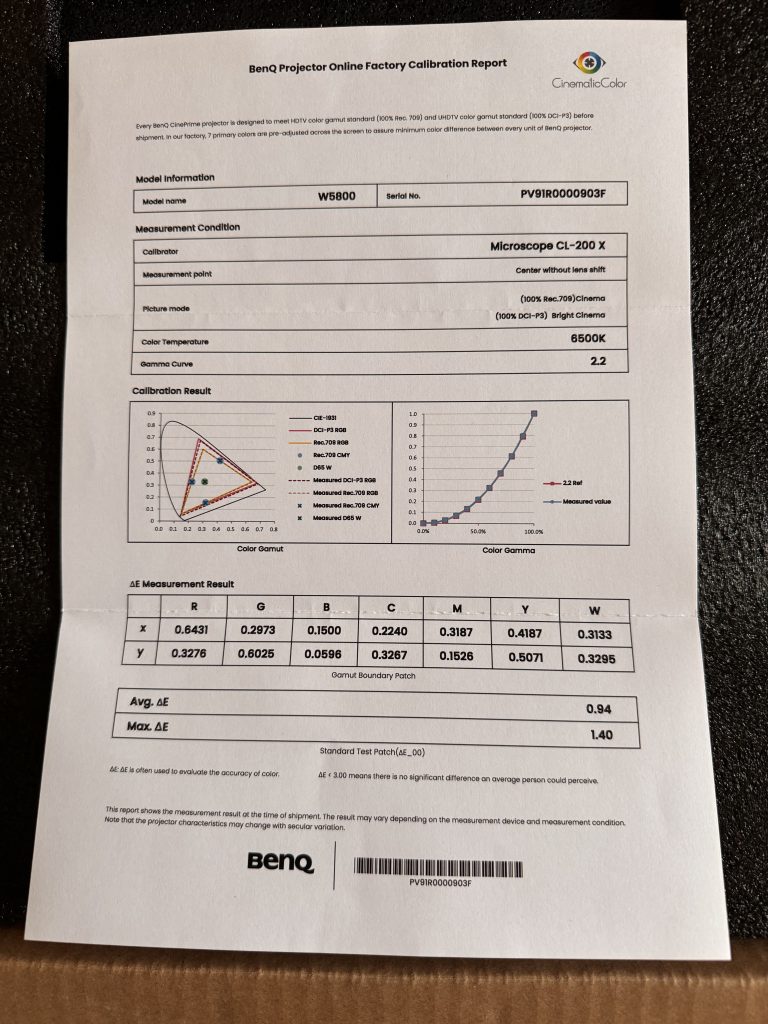 BenQ W5800 Factory Calibration Report
BenQ W5800 Factory Calibration Report
Despite its monochromatic blue laser light source, the W5800 fully covers the DCI-P3 color space and, of course, 100% of rec.709. These capabilities are automatically activated when an HDR/HLG/HDR10+ signal is detected and can be imposed in SDR via "Bright Cinema" mode. This DCI-P3 coverage is produced without the aid of a color filter, which makes it possible to maintain the entire light power promised by the manufacturer (2600 lumens).
BenQ plans a future update including self-calibration software accessible from the video projector menu, compatible with the i1 Xrite Pro colorimetric probe, intended for the general public. This feature should allow the user to maintain color balance regularly. However, I would have a reservation about using an entry-level probe to calibrate a laser projector, due to the potentially significant measurement errors this could cause, as explained in a previous article here.
The W5800 is expected to hit the American market in May 2024, priced at $5,999.
Projector Details
BenQ innovates with a shell designed specifically to minimize ventilation noise, thus guaranteeing an immersive viewing experience where only the sound of the projected film occupies the sound space. In my previous reviews of the brand's projectors, the noise of the cooling system was often mentioned as a point of annoyance.
The W5800 meets this challenge with a new design. Its fans are hidden behind discreet openings on the facade that suck in cool air in and then eject hot air to the sides. It is therefore essential to ensure that nothing obstructs these side vents which would hinder the optimal functioning of the device.
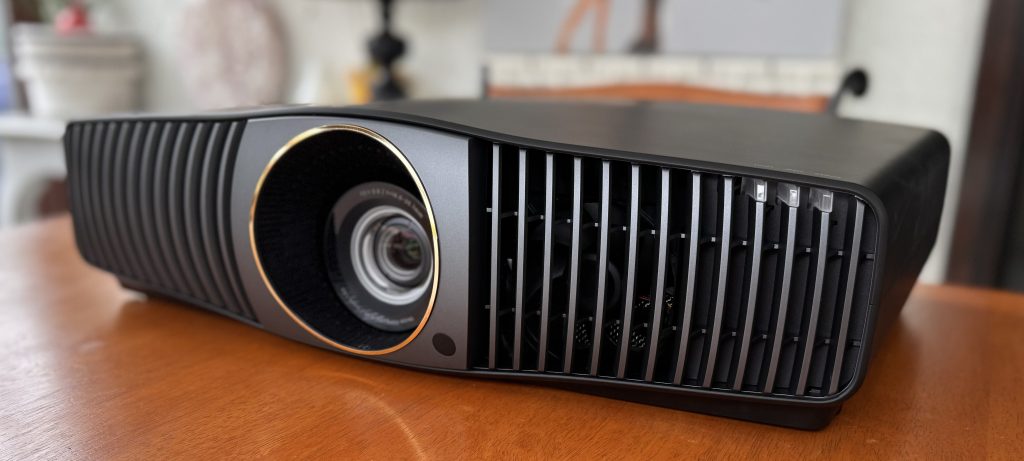 BenQ W5800
BenQ W5800
When it comes to design, tastes and colors are not really that important for a home theater projector that will mostly be used in a darkened room.
However, I must admit that the futuristic aesthetic of the W5800, with its central optics and its impeccable finish, does not fail to seduce me. With its imposing dimensions and dark gray color, this video projector is clearly intended to be the central element of a home theater room equipped with a large screen.
The W5800 measures 20.7” wide, 5.7” high, and 15.4 deep, and weighs 23.1 lbs. For precise adjustment of the image to your screen, the projector offers significant mechanical offset on the vertical and horizontal axes. If necessary, telescopic feet and electronic keystone correction can overcome any positioning difficulties.
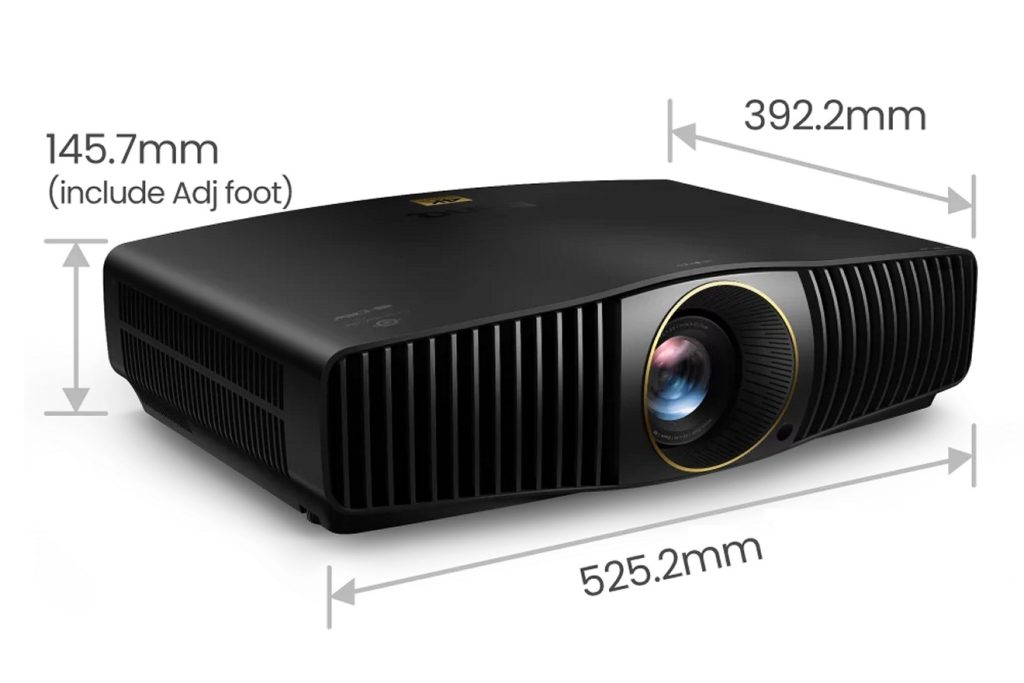 Dimensions BenQ W5800
Dimensions BenQ W5800
On the connectivity side, the W5800 offers two HDMI 2.0 ports compatible with HDCP 2.2, CEC/ARC, and eARC (single port), as well as two USB 2.0 type A ports for direct media playback from an external hard drive or USB key. A USB Type B port is also available for system updates. The integrated media player, unlike previous versions, supports most current video formats without difficulty.
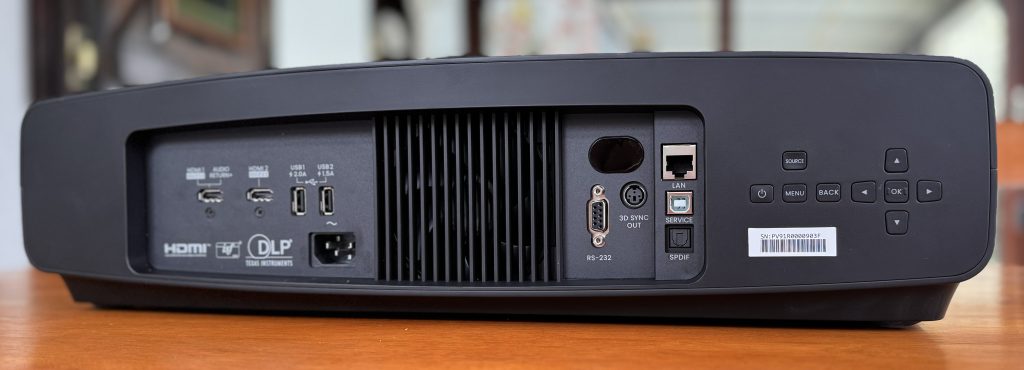 BenQ W5800 connectivity
BenQ W5800 connectivity
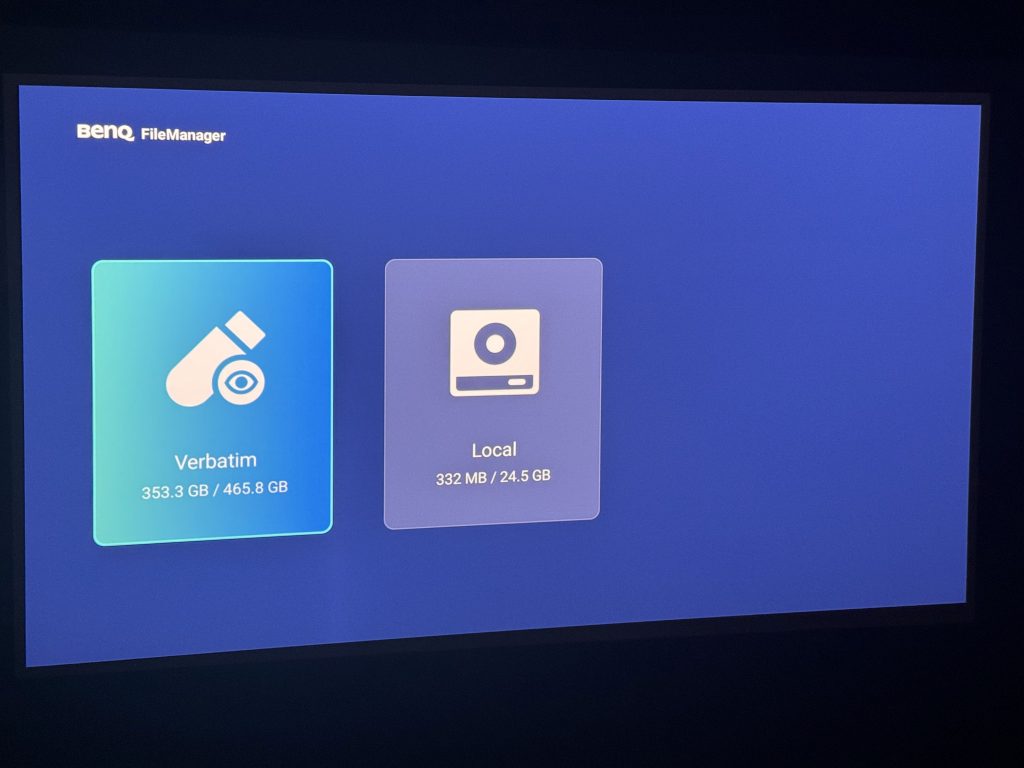 BenQ W5800 media player
BenQ W5800 media player
For audio, an S/PDIF output is provided, and a LAN socket allows you to connect the video projector to a network.
The large infrared remote control has practical backlighting for use in a dark room, with direct access to many functions. It’s bright enough to find in the dark but not too bright where it can distract.
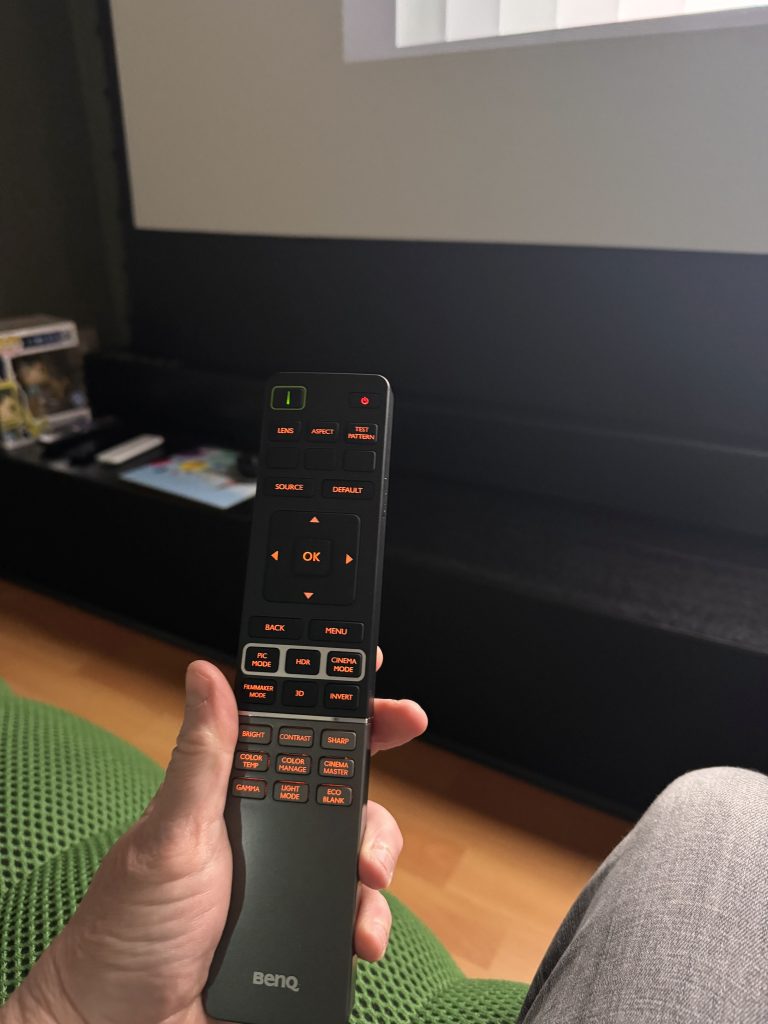 BenQ W5800 Remote Control
BenQ W5800 Remote Control
Menus and Settings
From the first start up, the W5800 offers the choice between a simplified menu interface and an advanced version for those wishing to fully exploit the capabilities of the device. Picture modes vary depending on the type of content detected, offering options like Bright, Bright Cinema, Cinema, and Filmmaker Mode in SDR, and HDR10, HDR10+, HLG, or HDR Filmmaker Mode in 4K HDR.
A save settings function is available to customize each picture mode. For precise calibration, 2-point (Gain and Offset) and 11-point adjustment options are offered, accompanied by a three-dimensional CMS (Color Management System) to adjust hue, saturation, and brightness. Gamma presets are also available, as are the classic hue, saturation, brightness, and contrast adjustments.
Three levels of light power management are selectable: normal, eco, and personalized. In custom mode, it is possible to adjust the laser light intensity from 50 (less powerful) to 100 (full power). A dynamic contrast setting can be turned on or off depending on preference.
Advanced video processing is grouped under the Cinema Master menu, offering a frame interpolation mode (MEMC) adjustable to four levels: off, low, medium, and high. This mode is operational on both SDR and HDR 4K sources.
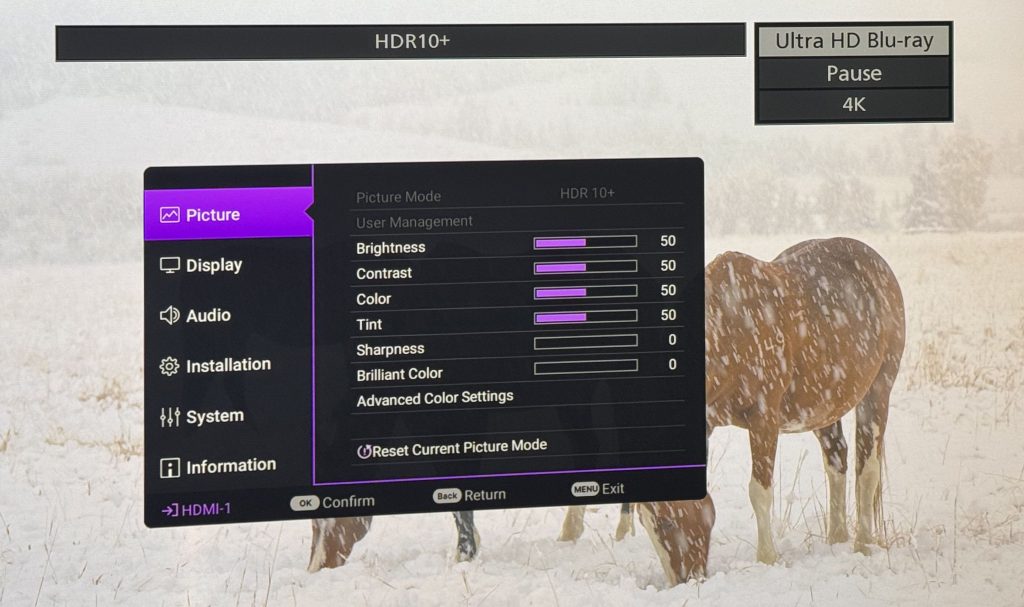 HDR10+ BenQ W5800
HDR10+ BenQ W5800
Finally, the HDR settings include a Local Contrast Enhancer option and specific control of EOTF (Gamma HDR), offering the possibility of intervening on possible clipping problems or blocked blacks. An information menu provides the encoding level (nits) of the 4K HDR content viewed.
Technical Evaluation
Image Sharpness and Precision
Like many of my readers, I would have preferred the implementation of a larger DMD chip (0.65 versus 0.47). It could have benefited both the contrast and the sharpness of the image. The designers of the W5800 preferred to focus their efforts on the optical unit and this is a choice that proves relevant because from one end of the image to the other the precision is excellent and allows you to benefit from all the advantages of a very high definition image.
Letters and numbers in my test image appear well decoupled/chiseled without a trace of chromatic aberration. An excellent vintage despite the presence of this DMD chip that all connoisseurs would like to see relegated to the oblivion of Texas Instruments in favor of larger versions.
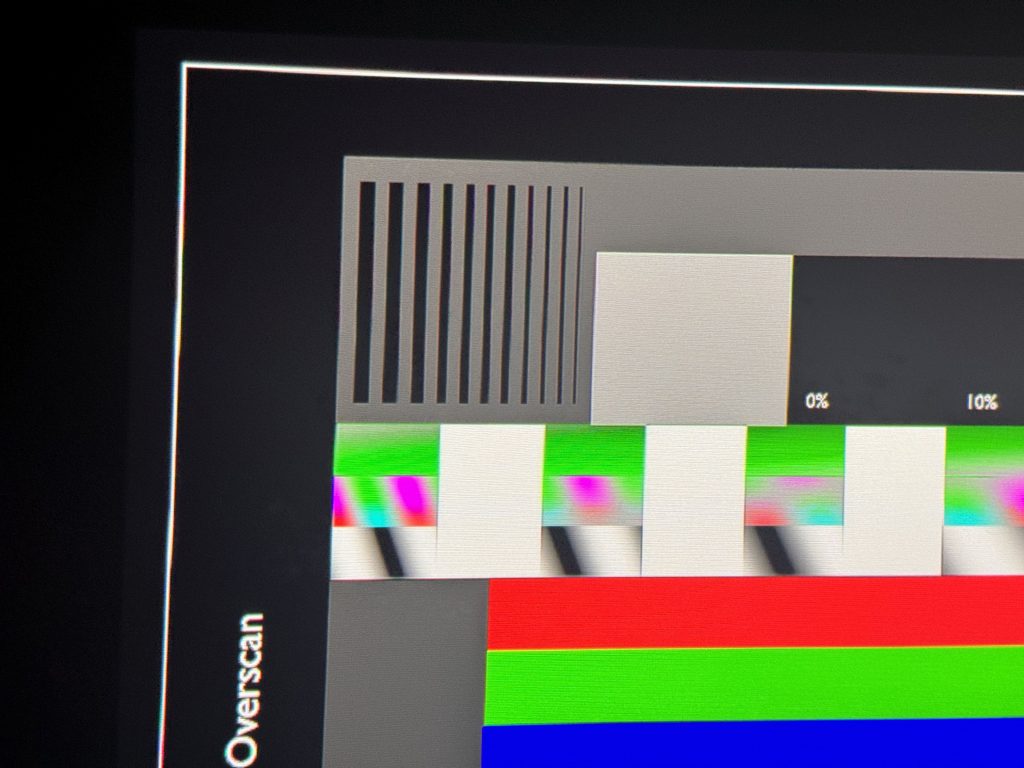 Image precision BenQ W5800
Image precision BenQ W5800
Contrast and Brightness
2600 lumens and a dynamic contrast of 2,000,000:1 are the manufacturer's promises for the BenQ W5800. For brightness it is held with 2548 lumens noted in the Bright mode, however with colors unsuitable for home cinema use. After calibration, 1743 lumens remain at full laser power, which allows projecting a 16:9 image of 190” Diagonal while maintaining a luminance of 16 fL with an SDR source.
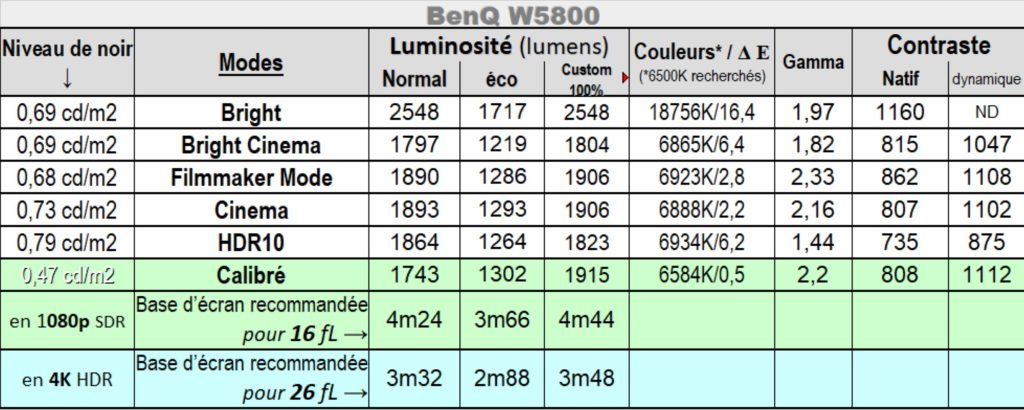 Contrast brightness colorimetry BenQ W5800
Contrast brightness colorimetry BenQ W5800
With an HDR program and a luminance of 26 fL it will be necessary to reduce the size of the image to a basic 150”. As you can see, this new model does not lack lumens and thanks to the fine management of its laser, it is possible to precisely adapt your dynamic needs to the size of your screen.
For the contrast, here we are far below the announced figure, which as with all dynamic contrast measurements, does not correspond to any real use of a projector. In fact, to reach such a figure, it is necessary to completely turn off the laser when a black test pattern is displayed and then turn it back on at full power to broadcast a completely white test pattern. This configuration will never happen during the broadcast of a film or TV series.
In short, my contrast measurements are not great but they are not surprising because they correspond to the levels expected with a DLP projector equipped with the DMD 0.47 chip. I therefore note a sequential FOFO (Full ON, Full OFF) contrast of 808:1 and a slightly improved dynamic contrast of 1112:1 (without pumping effect). Enabling the local contrast options in the Cinema Master menu had no impact on my measurements.
Colorimetry and Color Accuracy
Over the years BenQ has earned a reputation for outstanding color accuracy. The manufacturer has chosen for these home cinema models to offer a calibration report which corresponds to the copy in your possession. For the grader that I am, I know that this attachment to color fidelity will make my work easier because the basics will already be very good. Few manufacturers are involved in this approach and for BenQ we will see together that the advertising promises are reflected in the field measurements.
The calibration report provided with my test model indicates that SDR sources with a rec.709 color space must be used with the factory "cinema" mode and that to benefit from a wider Gamut at DCI-P3 references it You must use the bright cinema selection.
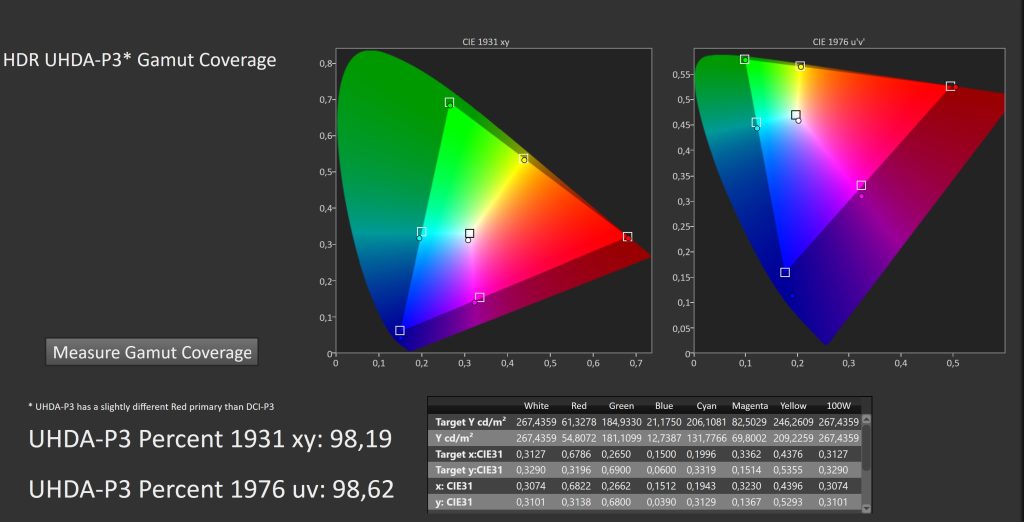 DCI P3 Coverage with Bright Cinema Mode BenQ W5800
DCI P3 Coverage with Bright Cinema Mode BenQ W5800
After running my probes and the projector for over half an hour, I first made a reference profile using my Jeti 1501 Hi Res reference spectrophotometer which has an accuracy of 2 nm. I then applied it to my K10A colorimeter to benefit from its speed and precision in low light. It was once these preparatory operations had been carried out that I was able to carry out my probe readings in front of my white reference screen.
In SDR the Gamut HDTV is covered at 100% and 98.62% for DCI-P3. Very good results obtained by implementing a color filter like in the W5700 and which has the disadvantage of lowering the overall dynamics of the image through a loss of brightness.
Checking the accuracy obtained with the corresponding factory mode, I must recognize that this projector can very well be used without additional calibration simply by using the cinema mode for SDR sources. Indeed in this configuration I measured a color temperature of 6888K with a deltaE difference of 2.2 and a Gamma of 2.16.
 Comparison before and after PVA calibration BenQ W5800
Comparison before and after PVA calibration BenQ W5800
However, I looked for perfection by applying calibration to the reference levels of the Professional Video Alliance (of which I am a member) and I found it!
So by simply using the 2-point setting of the gray scale, the CMS and the contrast and brightness adjustments I obtained a color temperature of 6584K (ideal sought 6500K with a deltaE deviation less than 2) with a deviation deltaE of 0.5. The color checker is of the same level with a margin of error of 0.5 and a Gamut of 0.4. This is simply exceptional for manual calibration but once again the very good results obtained out of the box with the factory settings can exempt you from professional calibration.
HDR Management
I am somewhat less enthusiastic about the HDR rendering because, despite the promise of automatic management with dynamic tone mapping, it still requires precise adjustment of contrast and brightness levels.
On most of the encodings tested, the W5800 was found wanting mainly on the clipping level. It will be necessary to lower the brightness level and increase the contrast to obtain a result that matches the references. We get there but with suitable brightness and contrast targets.
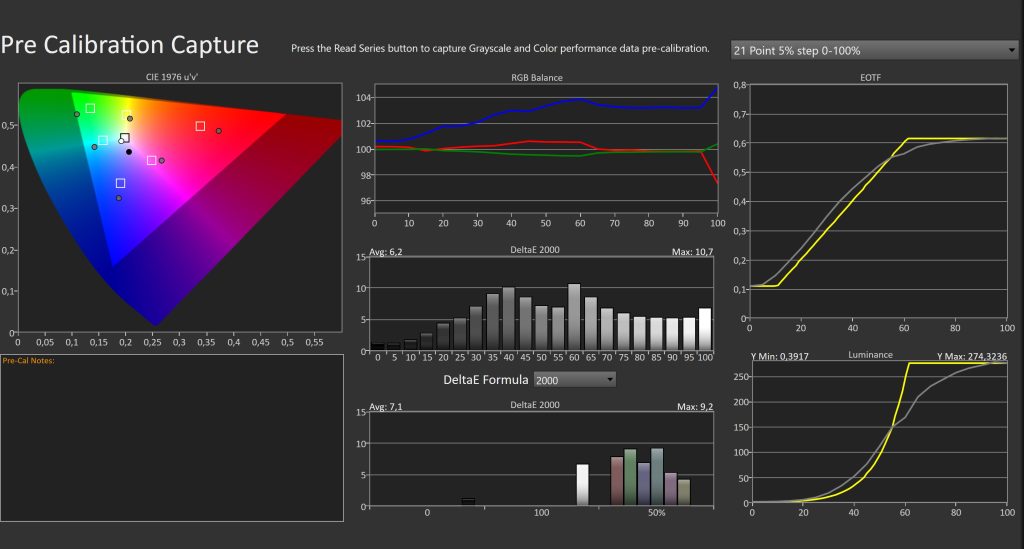 HDR10 out of the box BenQ W5800
HDR10 out of the box BenQ W5800
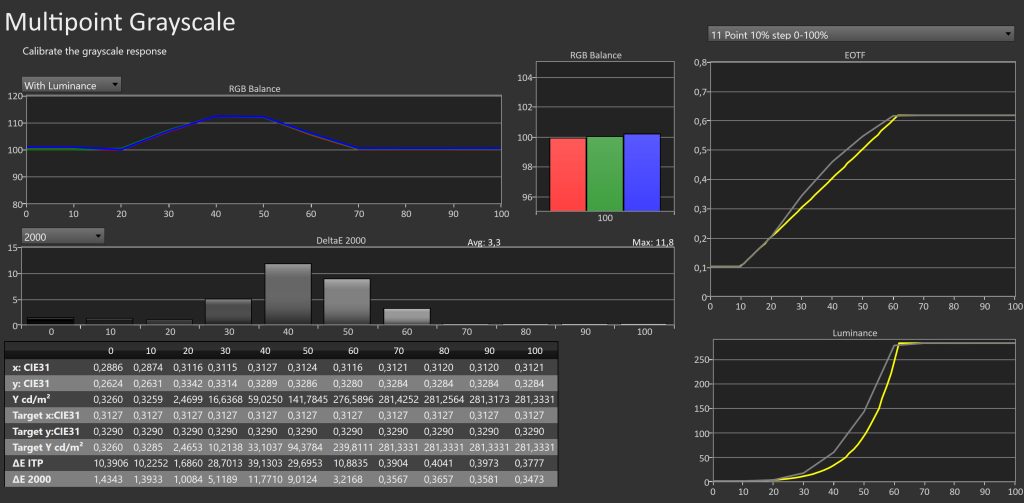 BenQ W5800 HDR post calibration
BenQ W5800 HDR post calibration
Taking into account HRD10+ sources is also far from the expected automation, i.e. dynamic management of metadata that this type of program should allow. On my 4K HDR10+ runs of Spear and Munsil, I found myself with burnt whites without any detail in the snow scenes including the characteristic one of the horses grazing in the snowy park, I resolved the problem by applying a reduction in the level brightness at -5 with my Panasonic UHD820 deck.
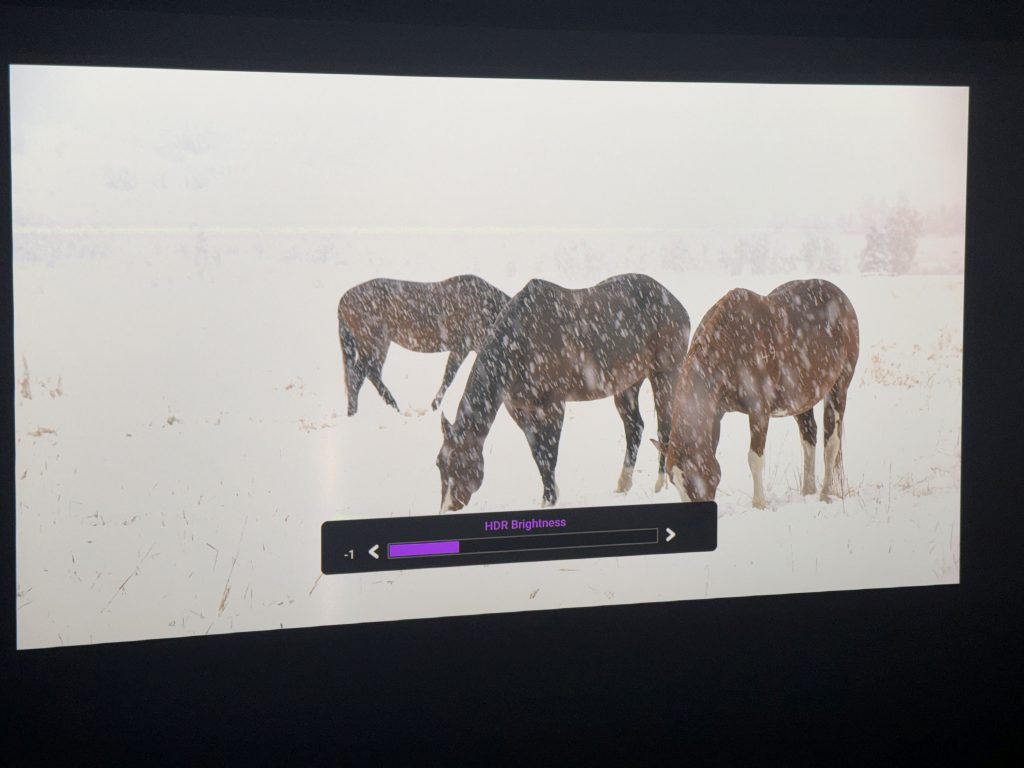 BenQ W5800 EOTF Setting
BenQ W5800 EOTF Setting
 Good 4K HDR horse reproduction
Good 4K HDR horse reproduction
Fluidity and Motion Handling
The other expected disadvantage with the presence of a DMD 0.47 chip is the presence of judder caused by poor conversion of incoming signals to 60hz but I must say that even without activating MEMC image interpolation, I did not suffer from his absence.
The fluidity aid does a superb job of improving precision in tracking shots from the lowest level, which allows the naturalness of the image and sharpness to be combined, in short you get the best of both worlds.
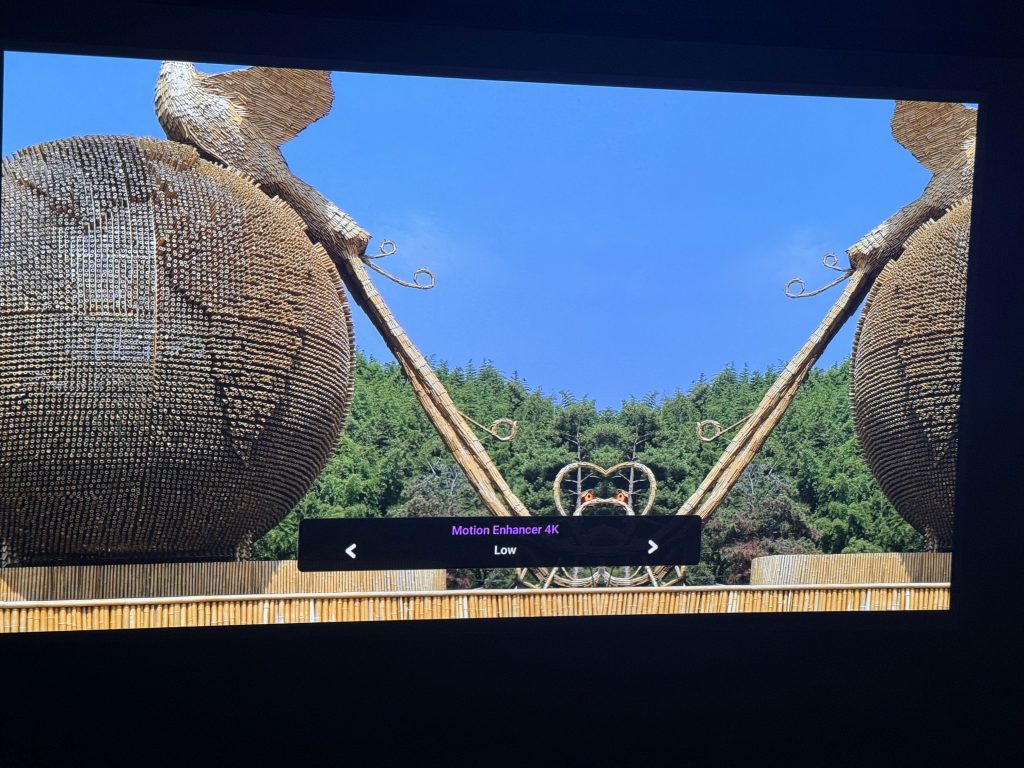 BenQ W5800 image interpolation
BenQ W5800 image interpolation
Input Lag
The W5800 is a projector whose core business and sole purpose is the most faithful reproduction possible of your film or series. It is therefore not equipped with Gaming and input lag reduction options. In these conditions I measure a high input lag of 141.7 ms but once again since we're using this projector to see movies like Dune in 4K we happily don't care!
 Input lag BenQ W5800
Input lag BenQ W5800
Laser Speckle
Laser speckle is a phenomenon encountered when using laser video projectors. The result? A kind of grainy pattern or small irregular spots of light on the projected image, called speckle. This phenomenon can make the image a little less sharp and more visually noisy, because these spots are not part of the original image and can be distracting or reduce the perceived quality of the image.
Laser projector manufacturers are working to reduce this speckle effect to improve image quality, by using different techniques to make the light less likely to interfere in this way, or by processing the image in a way that minimizes the speckle effect. appearance of spots.
When it comes to laser speckle, some models are less affected than others. This is the case of single laser devices with phosphor wheels like the W5800. Its image is spared by this defect in laser-based projection technology.
Overscan
Overscan and presence of the gray border around your image can be typical of projectors equipped with DMD 0.47 chips.
Using a dedicated test pattern, the overscan search can determine whether the projector's video processing is cropping out parts of the image. This is not the case here and even the very edges of the projected image appear fully on the screen.
The gray border typical of DMD 0.47 chips generated by inactive micro-mirrors is present with a usual width measured at .8 inches.
Operating Noise
This is one of the first elements I measured in this test. In fact, the brand's latest LED models that I tested all had the main fault of excessively high ventilation noise. The new design of the cooling system implemented in the innards of the W5800 allows for much more bearable operating noise. I note 37.5 dB with the laser at 100% power and 36.7 dB in economic mode. If we take into account the residual noise of 34.9 dB in my test room at the time of the readings, it is easy to understand that the W5800 is a discrete model, certainly not the quietest but more muted than most other home theater projectors.
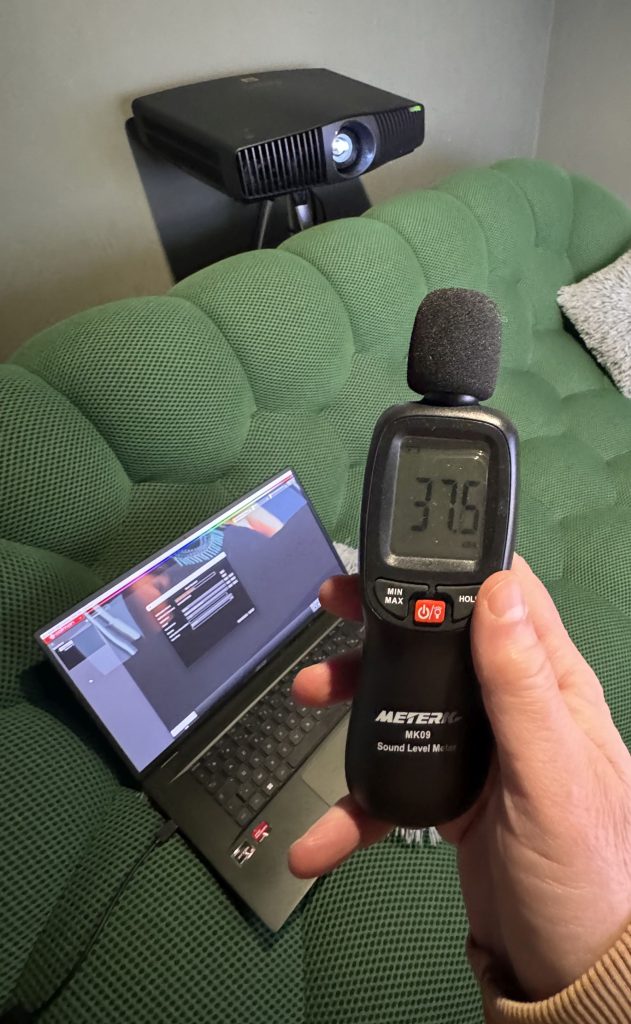 BenQ W5800 Full Power Laser Operation Noise
BenQ W5800 Full Power Laser Operation Noise
 BenQ W5800 eco mode operating noise
BenQ W5800 eco mode operating noise
Subjective Opinion
The crux of the matter in the field of projection is contrast. Unfortunately, the W5800 struggles to offer enough. In order to preserve its remarkable color accuracy and fidelity, I opted for a diversion from the usual use of my Celexon Home Cinema Plus screen. Although it is a projection surface designed for ultra short throw projectors, this canvas offers several significant advantages for the image of the new BenQ projector. Firstly, its low gain of 0.56 makes it possible to reduce the black level of the W5800 while preserving dynamics thanks to a large reserve of brightness. The other advantage of the Celexon screen lies in its colorimetric neutrality, meaning that specific calibration, unlike the use of a white canvas, is not required.
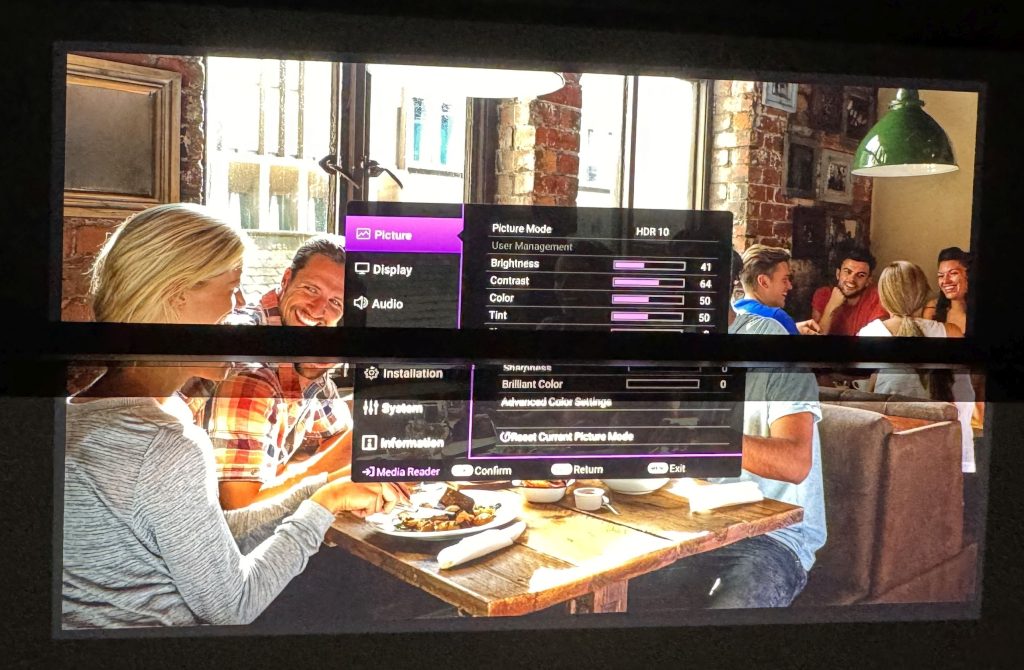 Technical screen at the top white screen at the bottom BenQ W5800
Technical screen at the top white screen at the bottom BenQ W5800
The comparative tests carried out in my dedicated room highlight the notable visual improvement brought by the association of the W5800 with the technical canvas, compared to the white canvas/ BenQ pair. Faced with complex scenes, such as the Bunker passage in the film "1917", blacks appear washed out and without depth on a white canvas. Conversely, projection on the Home Cinema Plus magnifies the result, thus overcoming the main weakness of the model.
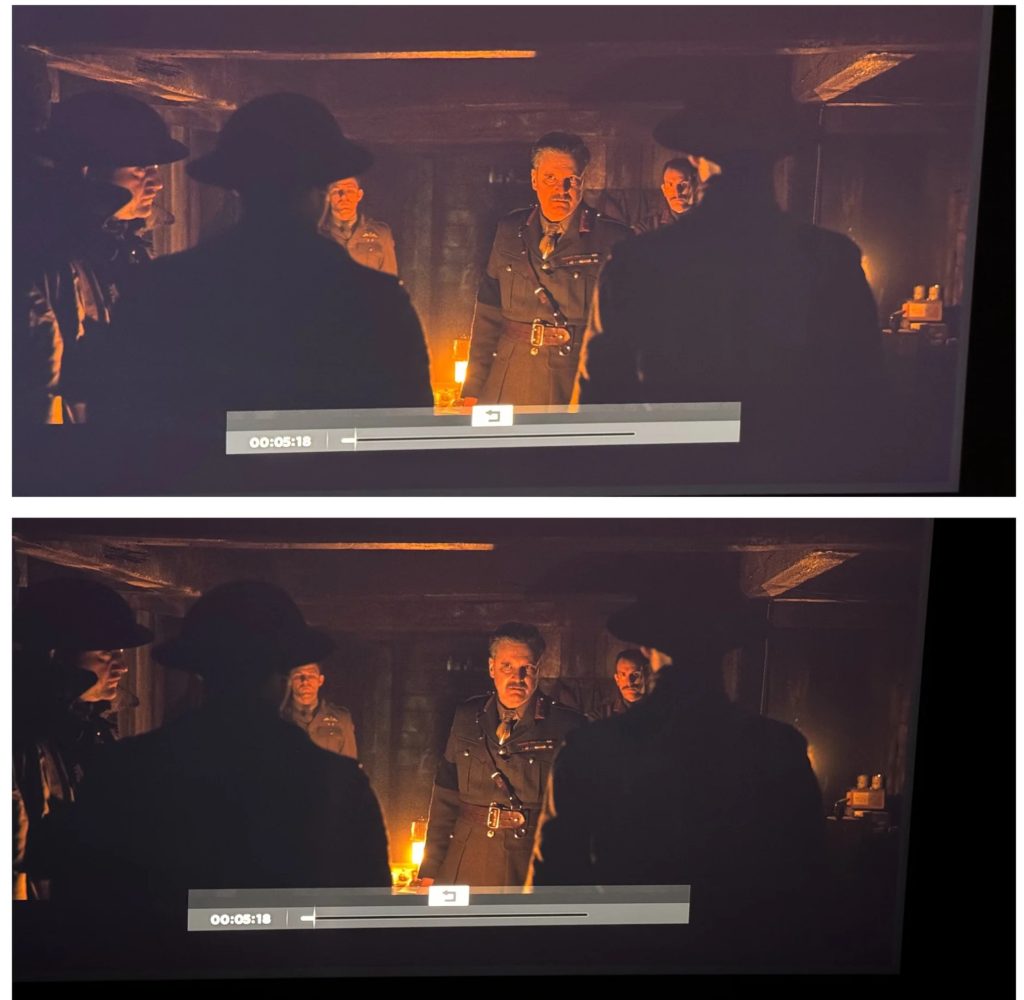 1917 BenQ W5800 white screen vs technical screen
1917 BenQ W5800 white screen vs technical screen
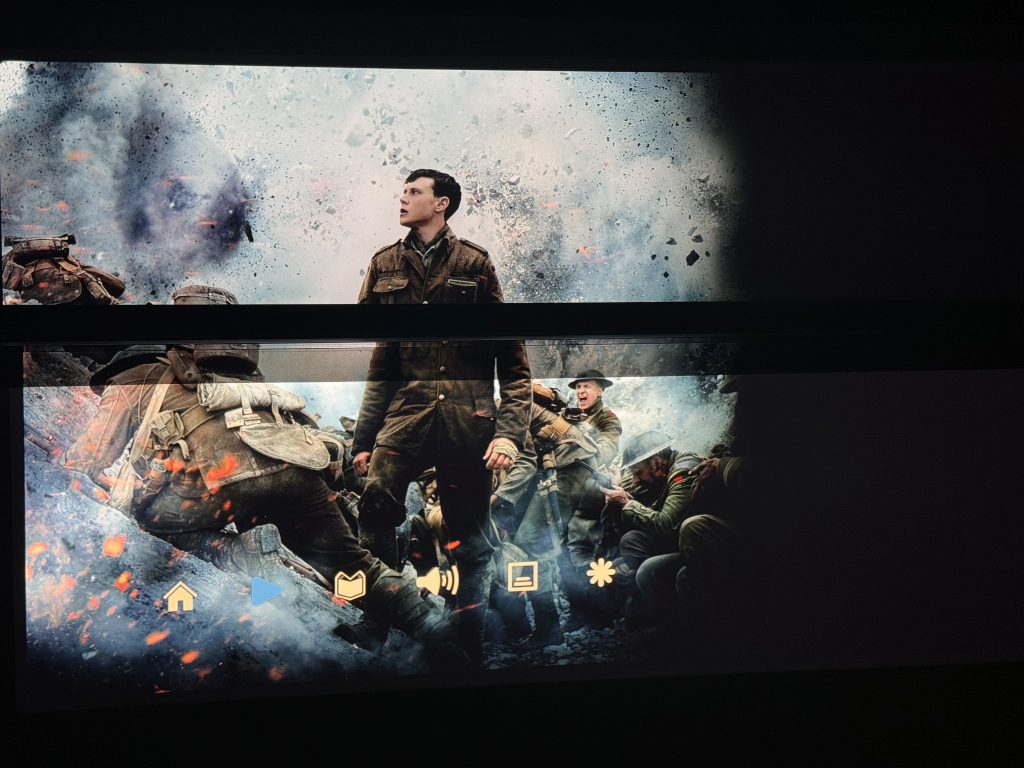 1917 BenQ W5800 technical screen at top white screen at bottom
1917 BenQ W5800 technical screen at top white screen at bottom
For this test, I only had a CLR cloth specifically intended for ultra short throw projectors. However, I am confident that using an ALR cloth, designed for standard focal length projectors, would provide similar benefits. It is crucial to avoid solutions based on color filters, which reduce the brightness of the device and cause significant alteration of colorimetry, requiring adjustment by professional calibration.
Opting for such solutions would be paradoxical, even demeaning, given the care taken by the designers of this device in optimizing its colorimetric performance and it would be a real shame when we see the image that the W5800 is capable of delivering!
 4K HDR10 BenQ W5800
4K HDR10 BenQ W5800
Conclusion
The W5800 embodies the essence of home theater. Forget gaming gadgets and unnecessary smart TV features: this model is designed to reign supreme in a dedicated room, accompanied by a high-quality audio system. True to BenQ's heritage, the W5800 shines with its extreme fidelity in color reproduction, precisely respecting the original intentions of the director and cinematographer. The brand's commitments are fully verified through my analyses, affirming that the designers have taken to heart the criticisms addressed to previous models by notably eliminating noise pollution and the shortcomings of media players.
Its main limitation, contrast, arises directly from the choice of the DMD chip. However, by combining the W5800 with a technical ALR screen with negative gain, this weakness is greatly reduced. By following this recommendation, you will get an unparalleled cinematic experience, characterized by impressive dynamics and precision, and above all, by exceptionally faithful color reproduction.
 Gold Award mondoprojos.fr
Gold Award mondoprojos.fr
At the end of this test, the BenQ W5800 was awarded a Gold Award mondoprojos.fr
Hisense PX3-Pro UST Projector Review
Read our in-depth expert review of the Hisense PX3-Pro Ultra Short Throw Projector, covering performance, image quality, features, and value. Discover why this projector might just be the best laser...
Keep Reading
BenQ W5800 4K Laser Home Theater Projector Review
In this review of the BenQ W5800, we take a comprehensive look into the features and performance of this new home theater projector. Our projection experts ran the W5800 though an exhaustive testing...
Keep Reading
Best 4K Projectors for 2024